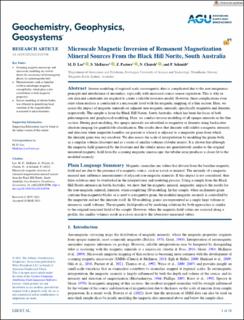| dc.contributor.author | Lee, Madeline | |
| dc.contributor.author | Mcenroe, Suzanne Amy | |
| dc.contributor.author | Pastore, Zeudia | |
| dc.contributor.author | Church, Nathan Stewart | |
| dc.contributor.author | Schmidt, Phillip | |
| dc.date.accessioned | 2023-10-31T07:36:10Z | |
| dc.date.available | 2023-10-31T07:36:10Z | |
| dc.date.created | 2023-05-20T10:24:04Z | |
| dc.date.issued | 2023 | |
| dc.identifier.citation | Geochemistry Geophysics Geosystems. 2023, 24 (5), . | en_US |
| dc.identifier.issn | 1525-2027 | |
| dc.identifier.uri | https://hdl.handle.net/11250/3099567 | |
| dc.description.abstract | Inverse modeling of regional-scale aeromagnetic data is complicated due to the non-uniqueness principle and interference of anomalies, especially with increased source-sensor separation. This is why in situ data and constraints are required to create a reliable inversion model. However, these complications even exist when analysis is conducted at a microscale level with the magnetic mapping of a thin section. Here, we assess the impact of magnetic minerals on adjacent non-magnetic minerals, specifically magnetite and ilmenite, respectively. The sample is from the Black Hill Norite, South Australia, which has been the focus of both paleomagnetic and geophysical modeling. Here, we conduct inverse modeling of all opaque minerals in the thin section. During post-modeling, the opaque minerals are identified as magnetite or ilmenite using backscatter electron imaging for quantifiable classification. The results show that ilmenite will exhibit a magnetic intensity and direction when magnetite lamellae are present or when it is adjacent to a magnetite grain from which the ilmenite grain was oxy-exsolved. We also assess the scale of interpretation by modeling the grains both as a singular volume (frustum) and as a series of smaller volumes (tabular arrays). It is shown that although the magnetic field generated by the frustums and the tabular arrays are quantitatively similar to the original measured magnetic field from the scanning magnetic microscope, the tabular array produces a closer fit to the modeled anomaly. | en_US |
| dc.language.iso | eng | en_US |
| dc.publisher | Wiley | en_US |
| dc.rights | Attribution-NonCommercial-NoDerivatives 4.0 Internasjonal | * |
| dc.rights.uri | http://creativecommons.org/licenses/by-nc-nd/4.0/deed.no | * |
| dc.title | Microscale Magnetic Inversion of Remanent Magnetization Mineral Sources From the Black Hill Norite, South Australia | en_US |
| dc.title.alternative | Microscale Magnetic Inversion of Remanent Magnetization Mineral Sources From the Black Hill Norite, South Australia | en_US |
| dc.type | Peer reviewed | en_US |
| dc.type | Journal article | en_US |
| dc.description.version | publishedVersion | en_US |
| dc.source.pagenumber | 18 | en_US |
| dc.source.volume | 24 | en_US |
| dc.source.journal | Geochemistry Geophysics Geosystems | en_US |
| dc.source.issue | 5 | en_US |
| dc.identifier.doi | 10.1029/2022GC010796 | |
| dc.identifier.cristin | 2148221 | |
| cristin.ispublished | true | |
| cristin.fulltext | original | |
| cristin.qualitycode | 1 | |

